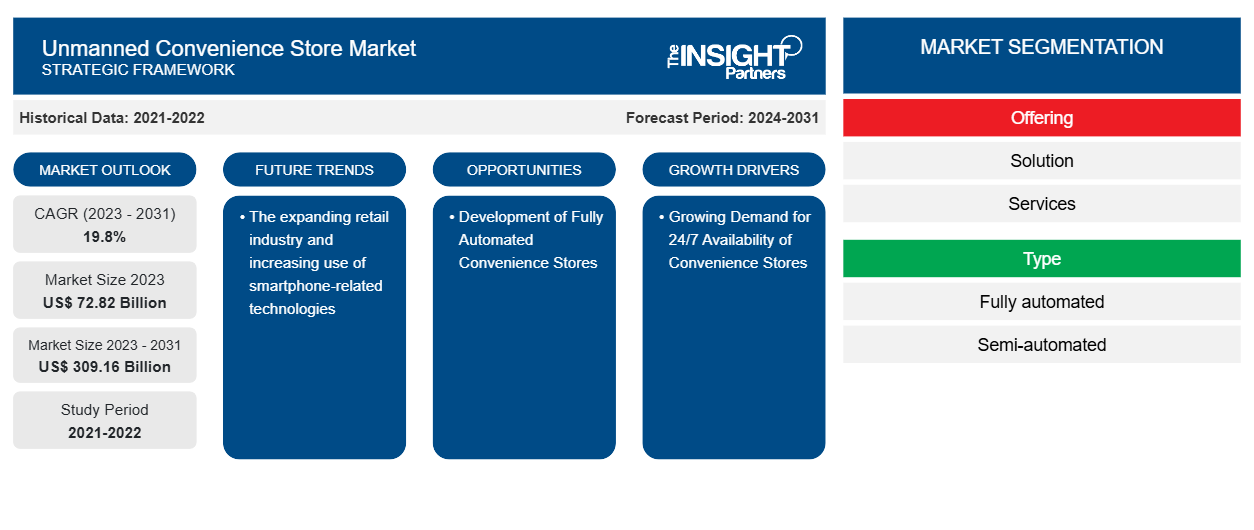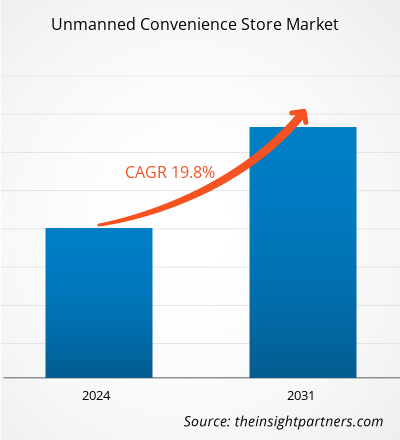The unmanned convenience store market size is projected to reach US$ 309.16 billion by 2031 from US$ 72.82 billion in 2023. The market is expected to register a CAGR of 19.8% in 2023–2031. The expanding retail industry and increasing use of smartphone-related technologies are likely to remain a key unmanned convenience store market trends.
Unmanned Convenience Store Market Analysis
The unmanned convenience store market is growing at a rapid pace due to the growing demand for 24/7 availability of convenience stores and increasing demand for shopping convenience among consumers. The market is expanding steadily, driven by the rising business need for cost optimization by enhancing consumer experience. Moreover, technological advancements and the development of fully automated convenience stores are providing lucrative opportunities for market growth.
Unmanned Convenience Store Market Overview
An unmanned convenience store is a type of retail stores that operate without any cashiers and customer care representatives are not physically present in the store. These stores use advanced technologies such as artificial intelligence and smartphone-related technology to manage daily activities and transactions. An unmanned convenience store is made to make it convenient for consumers to buy fast-moving goods, such as groceries or pharmacy supplies, whenever and wherever they choose. However, significant benefits offered by these stores, such as 24/7 availability, convenience, technological integration, self-serve and self-checkout, and cost-saving to both service providers of consumers, propelling the market.
Customize This Report To Suit Your Requirement
You will get customization on any report - free of charge - including parts of this report, or country-level analysis, Excel Data pack, as well as avail great offers and discounts for start-ups & universities
Unmanned Convenience Store Market: Strategic Insights

-
Get Top Key Market Trends of this report.This FREE sample will include data analysis, ranging from market trends to estimates and forecasts.
Unmanned Convenience Store Market Drivers and Opportunities
Growing Demand for 24/7 Availability of Convenience Stores is Driving the Market
The global unmanned convenience store industry is expanding due to the growing need for convenience with enhanced customer experience. Customers want access to products and services whenever they want, without having to deal with long lineups or make trips to physical stores. This increases the demand and development of unmanned convenience stores to meet consumers' demands. Unmanned convenience stores allow consumers 24-hour access to goods and services without requiring a staff member to be there in order to meet this demand. An unmanned store is a financially advantageous choice for companies, as it reduces the cost of paying staff. These factors are projected to boost the market during the forecast period.
Development of Fully Automated Convenience Stores - An Opportunity in the Unmanned Convenience Store Market
Growing digitalization and increased demand for autonomy among businesses are creating opportunities in the market. Businesses that use autonomous operations can save labor costs by eliminating the physical presence of employees in the store. This enables companies to concentrate and put their efforts into other domains, such as advertising, product endorsement, and client support. Automation allows unmanned convenience stores to lower security risks and insurance expenses. However, the growing demand and development of fully automated convenience stores that are not susceptible to theft or damage are generating significant opportunities for the market growth.
Unmanned Convenience Store Market Report Segmentation Analysis
Key segments that contributed to the derivation of the unmanned convenience store market analysis are offering and type.
- Based on offering, the unmanned convenience store market is divided into solution and services. The solution segment held a larger market share in 2023.
- In terms of type, the unmanned convenience store market is categorized as fully automated and semi-automated. The fully automated segment held a larger market share in 2023.
Unmanned Convenience Store Market Share Analysis by Geography
The geographic scope of the unmanned convenience store market report is mainly divided into five regions: North America, Asia Pacific, Europe, Middle East & Africa, and South America/South & Central America.
In terms of revenue, the North America market accounted for the largest unmanned convenience store market share, due to the growing need for contactless purchasing experiences and convenience. The market in North America is driven by the growing use of robotics and artificial intelligence technologies to automate the checkout process. Moreover, the availability of mobile payment methods is making it easier for consumers to shop without interacting with a cashier, which is fueling the market.
Unmanned Convenience Store Market Regional Insights
The regional trends and factors influencing the Unmanned Convenience Store Market throughout the forecast period have been thoroughly explained by the analysts at The Insight Partners. This section also discusses Unmanned Convenience Store Market segments and geography across North America, Europe, Asia Pacific, Middle East and Africa, and South and Central America.
Unmanned Convenience Store Market Report Scope
| Report Attribute | Details |
|---|---|
| Market size in 2023 | US$ 72.82 Billion |
| Market Size by 2031 | US$ 309.16 Billion |
| Global CAGR (2023 - 2031) | 19.8% |
| Historical Data | 2021-2022 |
| Forecast period | 2024-2031 |
| Segments Covered |
By Offering
|
| Regions and Countries Covered |
North America
|
| Market leaders and key company profiles |
|
Unmanned Convenience Store Market Players Density: Understanding Its Impact on Business Dynamics
The Unmanned Convenience Store Market is growing rapidly, driven by increasing end-user demand due to factors such as evolving consumer preferences, technological advancements, and greater awareness of the product's benefits. As demand rises, businesses are expanding their offerings, innovating to meet consumer needs, and capitalizing on emerging trends, which further fuels market growth.

- Get the Unmanned Convenience Store Market top key players overview
Unmanned Convenience Store Market News and Recent Developments
The unmanned convenience store market is evaluated by gathering qualitative and quantitative data post primary and secondary research, which includes important corporate publications, association data, and databases. The following is a list of developments in the market for unmanned convenience store and strategies:
- In February 2024, 7-Eleven Shop & Go is planning to open an unmanned convenience store in Tokyo and other areas. These unmanned convenience stores are operated by using smartphone payments to streamline operations. (Source: Nikkei Inc., Press Release, 2023)
Unmanned Convenience Store Market Report Coverage and Deliverables
The “Unmanned Convenience Store Market Size and Forecast (2021–2031)” report provides a detailed analysis of the market covering below areas:
- Market size and forecast at global, regional, and country levels for all the key market segments covered under the scope
- Market dynamics such as drivers, restraints, and key opportunities
- Key future trends
- Detailed PEST/Porter’s Five Forces and SWOT analysis
- Global and regional market analysis covering key market trends, major players, regulations, and recent market developments
- Industry landscape and competition analysis covering market concentration, heat map analysis, prominent players, and recent developments
- Detailed company profiles
Frequently Asked Questions
What is the incremental growth of the global unmanned convenience store market during the forecast period?
What will be the market size of the global unmanned convenience store market by 2031?
Which are the key players holding the major market share of the global unmanned convenience store market?
What are the future trends of the global unmanned convenience store market?
What are the driving factors impacting the global unmanned convenience store market?
What is the estimated market size for the global unmanned convenience store market in 2023?
- Historical Analysis (2 Years), Base Year, Forecast (7 Years) with CAGR
- PEST and SWOT Analysis
- Market Size Value / Volume - Global, Regional, Country
- Industry and Competitive Landscape
- Excel Dataset
Recent Reports
Testimonials
Reason to Buy
- Informed Decision-Making
- Understanding Market Dynamics
- Competitive Analysis
- Identifying Emerging Markets
- Customer Insights
- Market Forecasts
- Risk Mitigation
- Boosting Operational Efficiency
- Strategic Planning
- Investment Justification
- Tracking Industry Innovations
- Aligning with Regulatory Trends





















 Get Free Sample For
Get Free Sample For